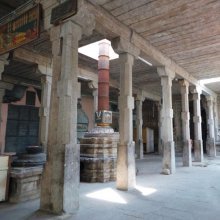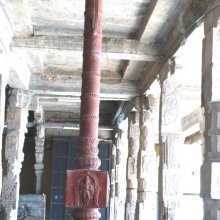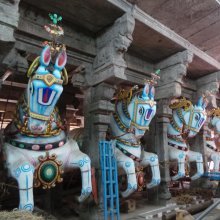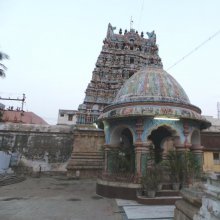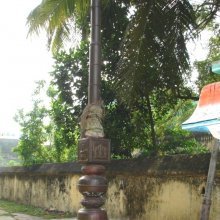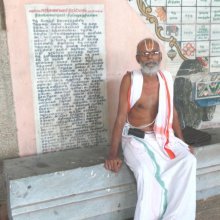Dhvajastambha, Dhvaja-stambha: 8 definitions
Introduction:
Dhvajastambha means something in Hinduism, Sanskrit, the history of ancient India, Marathi. If you want to know the exact meaning, history, etymology or English translation of this term then check out the descriptions on this page. Add your comment or reference to a book if you want to contribute to this summary article.
Images (photo gallery)
(+2 more images available)
In Hinduism
Vastushastra (architecture)
Source: Wisdom Library: Vāstu-śāstraDhvajastambha (ध्वजस्तम्भ) refers to the “flag post” erected in front of the mukhamaṇḍapa (‘front pavilion’) of a temple. The dhvajastambha is usually built within the temple walls (prākāra). They are seen to be made of wood and stone where the wooden variety is often finished with a metal covering (kavaca).

Vastushastra (वास्तुशास्त्र, vāstuśāstra) refers to the ancient Indian science (shastra) of architecture (vastu), dealing with topics such architecture, sculpture, town-building, fort building and various other constructions. Vastu also deals with the philosophy of the architectural relation with the cosmic universe.
Shaivism (Shaiva philosophy)
Source: Brill: Śaivism and the Tantric TraditionsDhvajastambha (ध्वजस्तम्भ) refers to the “signpost” (of a pub), according to the Mattavilāsaprahasana.—Accordingly, as the Kāpālika cries out: “My darling, look. This pub resembles the Vedic sacrificial ground. For its signpost (dhvajastambha) resembles the sacrificial pillar (yūpa); in this case alcohol is the Soma, drunkards are the sacrificial priests, the wine glasses are the special cups for drinking Soma, the roasted meat and other appetizers are the fire oblations, the drunken babblings are the sacrificial formulae, the songs are the Sāman-hymns, the pitchers are the sacrificial ladles, thirst is the fire and the owner of the pub is the patron of the sacrifice”

Shaiva (शैव, śaiva) or Shaivism (śaivism) represents a tradition of Hinduism worshiping Shiva as the supreme being. Closely related to Shaktism, Shaiva literature includes a range of scriptures, including Tantras, while the root of this tradition may be traced back to the ancient Vedas.
India history and geography
Source: Cologne Digital Sanskrit Dictionaries: Indian Epigraphical GlossaryDhvaja-stambha.—(CII 3, 4), a flag-staff. Note: dhvaja-stambha is defined in the “Indian epigraphical glossary” as it can be found on ancient inscriptions commonly written in Sanskrit, Prakrit or Dravidian languages.
Source: Heidelberg: Glory of the Tiruvanantapuram Padmanabhasvami TempleDhvajastambha (ध्वजस्तम्भ) refers to the “flag-post” of Hindu temples, according to the Syānandūrapuravarṇana-prabandha by Svāti-Tirunāḷ (1813-1846) (one of the rulers of Travancore) which deals with the different activities of the Thiruvananthapuram Temple, including ceremonies and festivals.—[...] The fifth chapter also gives a detailed sketch of the temple and its components, such as the balipīṭha (pedestal for food offerings) (5.8), various maṇḍapas (pillared halls) (5.9–10), vimānas (towers on top of the sanctum) (5.10), the single stone maṇḍapa (5.11), the dhvajastambha (flag-post) (5.12–14), the gopura (towers at the entrances) (5.14–15), the kulaśekharamaṇḍapa (5.15), etc.
Source: Yale Journal of Music & Religion: Ritual Music in Contemporary Brahmanical Tantric Temples of KeralaDhvajastambha (ध्वजस्तम्भ) refers to the “flagpole” of certain temples from Kerala sanctioned by the Tantrasamuccaya.—Such temples, alternatively called kṣetras or ambalams, consist of six parts: (1) the shrine, or śrīkōvil, and (2) the pañcaprākāras, the five successive enclosures surrounding it. [...] The bāhyahāra, the fourth enclosure, is the courtyard around the madhyahāra and includes various structures, sub-shrines, and stones installed at cardinal points. [...] The dhvajastambha, is the flagpole.

The history of India traces the identification of countries, villages, towns and other regions of India, as well as mythology, zoology, royal dynasties, rulers, tribes, local festivities and traditions and regional languages. Ancient India enjoyed religious freedom and encourages the path of Dharma, a concept common to Buddhism, Hinduism, and Jainism.
Languages of India and abroad
Marathi-English dictionary
Source: DDSA: The Molesworth Marathi and English Dictionarydhvajastambha (ध्वजस्तंभ).—m (S) A flagstaff.
Source: DDSA: The Aryabhusan school dictionary, Marathi-Englishdhvajastambha (ध्वजस्तंभ).—m A flagstaff.
Marathi is an Indo-European language having over 70 million native speakers people in (predominantly) Maharashtra India. Marathi, like many other Indo-Aryan languages, evolved from early forms of Prakrit, which itself is a subset of Sanskrit, one of the most ancient languages of the world.
Kannada-English dictionary
Source: Alar: Kannada-English corpusDhvajastaṃbha (ಧ್ವಜಸ್ತಂಭ):—
1) [noun] a pole on which a flag is raised and flown; a flag-pole.
2) [noun] a tall pillar of wood or stone, with somewhat tapered top, to which flag or flag-like metal plates are fixed, and installed in front of a temple.
Kannada is a Dravidian language (as opposed to the Indo-European language family) mainly spoken in the southwestern region of India.
See also (Relevant definitions)
Partial matches: Dhvaja, Stambha.
Full-text: Dhvajagambha, Dhvajadanda, Dhvaja, Balipitha, Jalayatra, Senagalaguduru, Gundlapalle, Yupa, Gopura, Mandapa, Vimana, Bahyahara.
Relevant text
Search found 6 books and stories containing Dhvajastambha, Dhvaja-stambha, Dhvajastaṃbha; (plurals include: Dhvajastambhas, stambhas, Dhvajastaṃbhas). You can also click to the full overview containing English textual excerpts. Below are direct links for the most relevant articles:
Later Chola Temples (by S. R. Balasubrahmanyam)
Temples in Chidambaram < [Chapter IV - Temples of Vikrama Chola’s Time]
Temples in Darasuram < [Chapter VIII - Temples of Rajaraja II’s Time]
Vastu-shastra (5): Temple Architecture (by D. N. Shukla)
Temples of Madura, the final phase (from 1600 A.D.) < [Chapter 12 - History of Hindu Temples (Prāsādas and Vimānas)]
Temples at Ellora and Elephanta < [Chapter 12 - History of Hindu Temples (Prāsādas and Vimānas)]
Temples of Khajuraho < [Chapter 12 - History of Hindu Temples (Prāsādas and Vimānas)]
Paraskara-grihya-sutra (by Hermann Oldenberg)
Somapalle Temple < [July – September, 1981]
Vastu-shastra (1): Canons of Architecture (by D. N. Shukla)
(vi) Rise of Art < [Chapter 4 - An outline History of Hindu Architecture]
Jainism in Odisha (Orissa) (by Ashis Ranjan Sahoo)
Structural Architecture < [Chapter 4]
Related products
